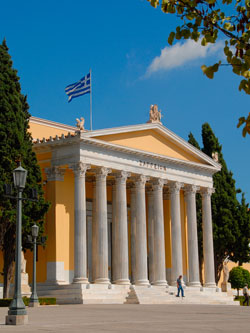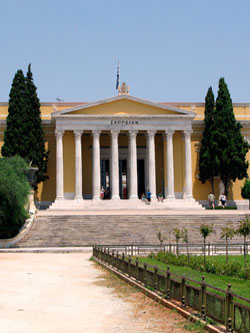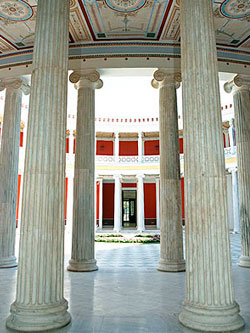


Athens Zappeion Hall
Zappeion Hall (Zappeion Megaro) is an imposing building at the southern side of the National Garden. From the expansive esplanade in front of it one can enjoy an excellent view to the eastern end of the Acropolis and the pine - clad Ardittos hill. The building serves as a national Congress and Exhibition Hall originally for national and international trade fairs. It was donated at the behest of the Greek government by the wealthy benefactor Constantinos Zappas (1813 - 1892) and named after him Zappeion. He and his elder brother Evangelos Zappas was second - in - command to Markos Botsaris, one of the principal leaders of the Greek Revolution. Afterwards both brothers went to Romania, where Evangelos Zappas, as a physician, attended the daughter of the Romanian King. In gratitude he was given land which produced great wealth for the family. Evangelos Zappas was one of the Greek supporters of the idea in the late 19th century to revive the Olympic Games. In 1870 the first revival attempt, the Zappieion Olympiads, were held in Athens. When Konstantinos Zappas died, he willed his family' s fortune to the Greek state.
The original plans for the Zappeio Megaro were drawn up by the French architect Francois - Louis - Flrimond Boulanger and work started in 1874. The resulting stately Neoclassical building, however, was designed by Theophilus Hansen (the architect of many buildings including the University building on Panepistimipou str) and completed by 1888. A large Roman bath complex was destroyed when the Zappeion was built. The Zappeion has a symmetrical facade with a central temple - like entrance element. This is flanked on each side by two again simpler templesque halls joined to the entrance structure by lower portico - storey building surrounding a smaller, circular component with a circular central court. This handsome and much photographed space has an elegant columned portico on each level. This is a very attractive enclosed but open space. The building was renovated in 1959/60. Besides serving as an exhibition hall for temporary governmental, artistic and commercial exhibits, it also once housed the headquarters of the 2004 Athens Olympic Games Committee (now on Kifissias ave. On weekends during the joyous Carnival season (Apokries), before the start of Lent (Sarakosti), thousands of children accompanied by their parents come here to the broad space in front of the building in their colorful costumes and masks to promenade, to make loud, obnoxious noises with various plastic noise - makers, to hit people on their heads and bodies with plastic mallets and to throw copious amounts of confetti and streamers at each other. It is a feast for people watchers, photographers and food vendors alike!
One either side of the central entrance complex is a statue on a tall base in front of a stately cypress tree: the one on the left is Evangelos Zappas (1864, by the Greek sculptor Ioanis Kossos) holding a wreath, and the other is Constantinos (1893, marble, by the Greek sculptor Georghios Vroutos, 1843 - 1908).
The building has its own gardens around it. To sample these take the broad, straight, tree-shaded streets to the northwest. Many of the romantic - style statues set in the gardens came from the former Nikolaos Thon. Estate in the modern district of Ambelokipi (bordered on the east by Kifissias Ave and on the south by Alexandras ave.) after the villa there (built by Ernst Ziller I 1880) was blown up in 1944, during the Decemvriana conflict. There are some marble busts and an ornate marble monument (1870 - 1886) along the way to the west. This marble monument (1870m - 1886, by the Geek sculptor Leonidas Drosis, 1834 - 1882) commemorates Ioannis Varvakis, a rich merchant from Epirus. The allegorical figures seated around the base represent what he contributed to hid country during his life: a freed Greece, history, intellect and the merchant marine. Varvakis donated the money for the firs model state school for talented boys, the Varvakeion. The equivalent school for girls is the Arsakeion. A part of the Central Market now occupies the Varvakeion's site.
